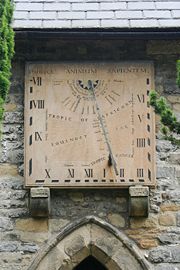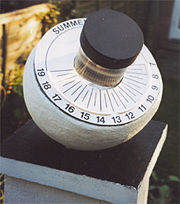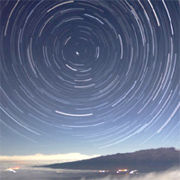Sundials
A sundial is a device that measures time by the position of the Sun. In common designs such as the horizontal sundial, the sun casts a shadow from its style (a thin rod or a sharp, straight edge) onto a flat surface marked with lines indicating the hours of the day. more...
As the sun moves across the sky, the shadow-edge progressively aligns with different hour-lines on the plate. Such designs rely on the style being aligned with the axis of the Earth's rotation. Hence, if such a sundial is to tell the correct time, the style must point towards true North (not magnetic North) and the style's angle with horizontal must equal the sundial's geographical latitude. However, many sundials do not fit this description, and operate on different principles.
Introduction
Sundials can be categorized in several ways. First, some sundials use a spot of light, or a line of light, to indicate the time, where others use the edge or tip of a shadow. In the former case, the spot of light may be formed by allowing the sun's rays through a small hole or reflecting them from a small circular mirror; a line of light may be formed by allowing the rays through a thin slit or focusing them through a cylindrical lens. In the other case, the shadow-casting object — the sundial's gnomon — may be a thin rod, or any object with a sharp tip or a straight edge. Second, sundials employ many types of gnomon. The gnomon may be fixed or moved according to the season; it may be oriented vertically, horizontally, aligned with the Earth's axis, or oriented in an altogether different direction determined by mathematics. Third, sundials may use many types of surfaces to receive the spot or line of light, the shadow-tip or shadow-edge. Planes are the most common surface, but partial spheres, cylinders, cones and even more complicated shapes have been used for greater accuracy or intriguing aesthetics. Fourth, sundials differ in their portability and their need of orientation. The installation of many dials requires knowing the local latitude, the precise vertical direction (e.g., by a level or plumb-bob), and the direction to true North. In contrast, other dials are self-aligning; for example, two dials that operate on different principles, such as a horizontal and analemmatic dial, may be mounted together on one plate, such that their times agree only when the plate is aligned properly. Sundials were an important aspect of the Greek and egypitan civilizations up to the 16th century.
Sundials indicate the local solar time, unless otherwise corrected. To obtain the standard clock time, three types of corrections need to be made. First, the solar time needs to be corrected for the longitu
Read more at Wikipedia.org





